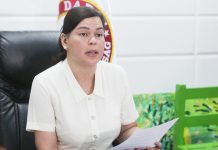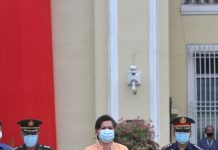DAVAO City came a step closer to the implementation of the Davao City Watershed Code when the multi-sectoral Watershed Management Council (WMC) headed by Mayor Sara D. Carpio approved last week a strategic framework for the protection, conservation and management of the city’s major watershed areas.
The framework, a result of a series of consultations with stakeholders last year, addresses at least a dozen major issues and concerns, according to City Administrator Zuleika T. Lopez, WMC vice chairperson, who presided over the meeting with Councilor Arnolfo Ricardo B. Cabling and acting City Agriculturist Leonardo Avila III, who co-authored the watershed code in 2007.
Lopez said the framework was drafted by a technical working group (TWG) and was submitted for discussion and comments with representatives of various government agencies, barangay captains in identified watershed areas, members of barangay watershed management councils (BWMCs) organized last year, the indigenous peoples, landowners, small and big agricultural plantations and various other stakeholders, such as non-government organizations, the academe, the religious sector, the Davao Medical Society, Davao City Chamber of Commerce, the Integrated Bar of the Philippines and media.
The framework, a dynamic document subject to revisions as the need arises, will serve as reference in crafting a specific management plan for each of eight major watershed areas in the city. It lays down six goals and addresses 10 major issues identified during the series of multi-sectoral meetings and consultations last year.
Avila said the watershed areas were pinpointed through a terrain analysis conducted by the city government in a joint undertaking with the Mines and Geo-sciences Bureau of the Department of Environment and Natural Resources.
The framework provides for a set of objectives and strategies seeking
–to delineate boundaries of identified conservation areas, agricultural non-tillage and prime agricultural areas through a perimeter survey;
–to conserve groundwater for future domestic use by rehabilitating and developing 93,080 hectares of open land, brush and mangrove areas through a reforestation program and related activities;
–to harmonize national and local policies and regulations and strictly enforced them;
–to provide alternative livelihood programs for occupants/ settlers within conservation and non-tillage areas;
–to develop sufficient resources needed to implement policies and programs on watershed management through the promotion of multi-sectoral, inter-agency and community participation and the generation of funds through co-management agreements, submission of proposals to local and international donor institutions and collection of environmental users tax; and to implement a massive continuing information, education and communication (IEC) program designed to make all stakeholders understand and internalize the life-and-death importance of protection, conservation and management of the city’s watersheds.
Councilor Marissa S. Abella, current chairperson of the SP committee of environment, said there should be no letup in the WMC’s consultations with stakeholders, especially those initially feel threatened by the watershed code’s implementation.
Abella, one of two councilors who are members of the WMC, bared that the framework also tackles some ticklish issues such as titled lands within the protected areas, expansion of agricultural plantations within conservation and agricultural non-tillage areas, deliberate misinformation on the watershed code provisions, weak enforcement and monitoring of provision on buffer zones, and improper waste management and presence of pollutants in rivers and other bodies of water in the city.
Ms Lopez added that other major issues included in the WMC’s “perpetual concerns,” are climate change, disaster preparedness, rapid population growth of the city, in-migration, finite ground resource and intrusion of salt water into the aquifers and implementation of the Rainwater Harvesting Ordinance.
The newly-approved framework will now be the basis of a comprehensive, systematic and community-based approach to protection, conservation and management of the major watersheds in the city, she said.
0 Comments
Oldest






